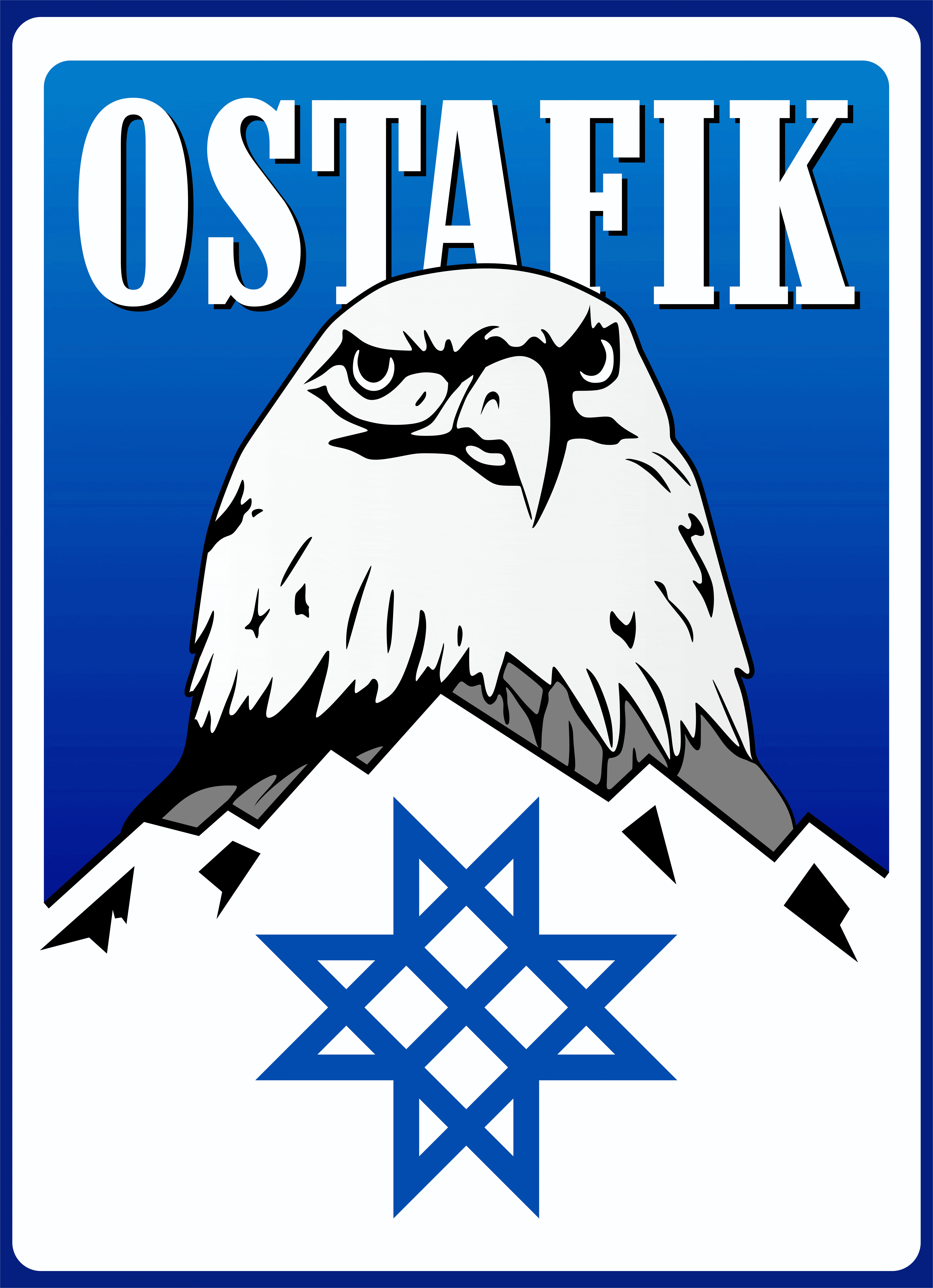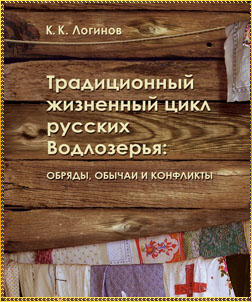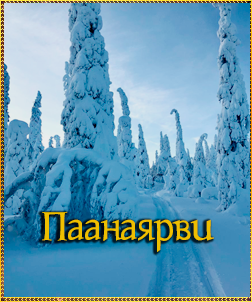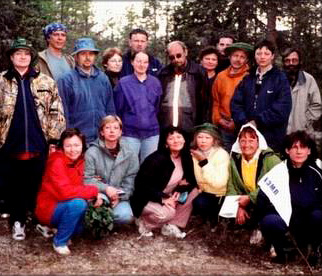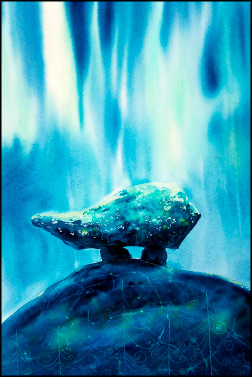Сампо оставляет загадки на страницах «Калевалы»
Ари Берк (Ari Berk. ari.david.berk@cmich.edu).
журнал "Realms of Fantasy".
Создавая свое «Средиземноморье», Толкиен наполнил тот мир мифическим содержанием, музыкой слов, магией мест, создал его персонажи и пейзажи настолько жизненными, что создается ощущение, что они существуют на самом деле. Хорошее знание ранней литературы и фольклора Северного мира, особенно Финляндии, помогло ему достигнуть этого эффекта. Действительно, пожалуй, нет более значительного cобрания европейских мифов и легенд, чем финский эпос «Калевала», в котором собраны сотни песен и заклинаний финского устного творчества 19 века.
Посредством мифов и легенд о происхождении мира мы имеем уникальный шанс изучить метафорический язык культуры. В короткой песне о том, как создавалась кошка, мы до сих пор находим актуальные высказывания об общественной и сексуальной культуре.
Хийси был одним из лесных богов, воспринимавшийся как гениальный лось (или дух-защитник). В христианской культуре он стал ассоциироваться со злом и даже с дьяволом. Символические взаимоотношения Хийси с котом, могут свидетельствовать о дикой природе существа ранее, сомнительного лесного происхождения, или об общих связях с колдовством как со знакомым духом (верования были общие по всей Европе). Это имя, наряду с высказываниями «ядовитый» и описаниями «гонки с волком», представляет кота не только как хищника, но и наделяет его потусторонними способностями и склонностью желать зло. Ссылки на печи и «женский нос» могут привлекать внимание к домашней природе волшебства кота, ассоциациями с женщинами вообще. Это - неприятная, но общая ирония североевропейского фольклора: женские способности часто вызывали подозрения, плохо рассматривались, даже по отношению к знакомой бытовой сфере. На кошку – которая по природе своей символ домашнего очага – переносятся эти ассоциации, которые, несомненно, усиливаются ее ночным образом жизни.
Также в статье объясняется происхождение образов собаки, лодки, дается комментарий к песням о Сампо в «Калевале».
At sea between one world and another, the heroes of the Kalevala must defend the Sampo during their flight from Northland
Shall I start to sing
Shall I begin to recite
With a good man as a partner wo
who grew up together?
Come, let us put hand in hand
And finger in finger-gap
Each grip in the other's grip.
One word from you, one from me
Splendid speech from both:
We will shape our mouths
We will pitch our tunes
Like two kanteies
Like five or six gates
Three doors of a hut.
(Kuusi: 81)
So begins the Prologue to the outstanding collection, Finnish Folk II Poetry Epic. Within the Finnish lore are words of sharing, songs of partnership, charms of invitation from across the ages. Many have heard these songs and accepted the call of an ancient chorus. Many have heard the music of the Northland and followed it back to the beginning of the world. The words are still here, hanging on the air, waiting to be answered.
When Tolkien created his Middle-Earth, he imbued that world with mythic resonance, with word-music and place-magic giving his characters and landscape depth, vitality, and a sense of actual existence. One of the ways he accomplished this was by drawing from his impressive knowledge of the early literature and lore of the Northern world and particularly of Finland. Indeed, there may be no greater storehouse of ancient European myth and legend than the Finnish national epic, the Kalevala (assembled by the scholar Elias Lonnrot in the 19th century), and the hundreds of songs and spells that have been collected from Finnish oral tradition since the 19th century.
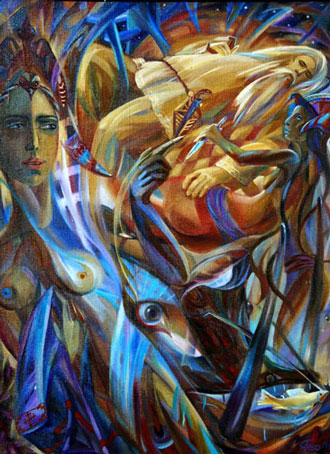
"Perhaps because of their geographical remoteness, the Finnish tales and songs possessed—Tolkien believed—a truly Northern mythology unsullied by contact with the rest of Europe. Certainly they retain strong connections to a mythic world that thrived before the advancing of an Industrial Age. Now no myth or culture exists in a vacuum, but the particular ancientness and singular eloquence of Finnish lore provided Tolkien with the inspiration to create such a mythology for his own country of England. One branch of his elvish language is founded upon the sound of Finnish, and several of the gods in his Silmarillion—Ulmo and Illüvatar—bear names highly reminiscent of gods from the Finnish pantheon— Ilmo and Ilmatar" (Shippey, 215).
Yet, Tolkien was not the first teller of tales to define and associate the Finnish myths and people with otherworldly artistry and authority. Some of the early written accounts of the Finns contained in Olaus Magnus's A Description of the Northern Peoples (1555) establish both respectful and wary opinions of the power of Finnish spells and enchantment among their neighbors. Magnus begins with a general comment and then a specific example of one common type of Finnish magic:
"I would first like to say this-, that Finland, the northernmost land, together with Lappland, was once during pagan times as learned in witchcraft as if it had had Zoroaster the Persian for its instructor.... There was a time when the Finns ... would offer wind for sale to traders who were detained on their coasts by offshore gales, and when payment had been brought would give them in return three magic knots tied in a strap not likely to break. This is how these knots were to be managed: when they undid the first they would have gentle breezes; when they unloosed the second the winds would be stiffer; but when they untied the third they must endure such raging gales that, their strength exhausted, they would have no eye to look out for rocks from the bow, nor a footing either in the bottom of the ship to strike the sails or at the stern to guide the helm" (Book III, 172-173).
Like most early modern ethnographic writers, Magnus employs a comparative method, evoking the name of the famous Persian sorcerer Zoroaster to shroud the Finns in foreign mysticism for his readers. The example of wind-related enchantment is significant. Depicting them as wind traders and controllers, Magnus makes an important association between Finnish magic and the natural world. Despite the reference to foreign Zoroaster, the Finns are not defined as conjurors of spirits, but as indigenous natural wizards, conjuring and controlling the powers abounding in the sea, land, and air around them.
In another account, Magnus relates the trouble encountered by a Swedish hero, Arngrim, when battling against the Finns: "They devote themselves no less to magical skills, and know how to receive or inflict blows by attacking and fleeing on curved boards across the snowfields. These men Arngrim assaulted and crushed, as Saxo testifies, for the sake of winning fame. After they had had the worst of the conflict and had dispersed in flight, they threw behind them three pebbles and made them appear to their foes like three mountains. Arngrim therefore, stunned by the uncertainty of his deluded vision, recalled his troops from the pursuit, believing that he was cut off from the enemy by a wall of towering cliffs. The next day they encountered him again and, when they were beaten, scattered snow on the ground, giving it the semblance of a mighty river. The Swedes, utterly deceived by the illusion, completely misread the situation and thought that an extraordinary volume of roaring waters lay before them. As the victors quaked at this meaningless apparition, the Finns made good their escape" (Book V, 256). Magnus is dismissive of the craft of illusion, but again, he allows us to perceive the intrinsically associative nature of Finnish magic. It is tied to the landscape, born out of the rocks and snows. It is part of the landscape and can, if needed, rise up out of even the smallest piece of stone to muddle the minds of their enemies. It is as if the land itself comes to the aid of the Finns, producing mirrors of its mountains and the shadow of its waters to protect those people who know how to call upon it.
Not only associative, the Finnish mythic landscape is a fully sentient world. Trees speak, animals talk, and every living thing holds the potential for communication if the right words are spoken, if the right charms, or runes, are sung. But because the natural world is alive, often following its own concerns and agendas irrespective of human needs, that world is also dangerous. Animals, plants, and places could harm a person physically and spiritually, and so many kinds of charms were needed to help mortals and deities negotiate a potentially perilous world. The varied categories of Finnish lore, many of which are found in the wonder-filled land-scape of the Kalevala, are as wide as the Northern winter. In addition to the tal included in the Kalevala, Lonnrot edited and published a large collection of magical songs and classified their contents under headings to denote their purposes and use.
He begins with 18 general formulas which he calls preliminary (used when the magician was about to begin conjuring), defensive (used while on a journey to defend against attacks of witches and evil wishers), envy (used to ward off the ill effects of jealo glances), vengeance (used to inspire fear in an enemy), origination (used in healing the sick by detecting the origin of a disease, if such was uncertain), reparation (used to invoke the originator or cause of any injury or disease to repair the damage it had caused), inflammation (used for snake bites), expulsion (used to cure many diseases, but especially those caused by elf-shot and witchcraft), posting (recited after an expulsion or menacting formula), pain (used to comfort aches and contusions), reproaching (used after a snke bite or wound caused by an animal; also for toothache and wounds caused from fire, cold and natural causes), ecstasy (used to make the magician invigorated), distressed (used to address sudden attacks of disease or pain ), boasting (used to build confidence and disparage a foe), stilling (used to assuage great pain), menacing (these were added after an expulsion charm when it had proved insufficient), exorcising (used to dispel curses, evil spells, and disease caused by witchcraft), and fastening (charms used to hold evil spirits motionless). Then he designates 40 liberating or healing charms; 52 classes of magic spells and charms to be recited on such occasions as divining, hunting, fishing, and marriage etc.; 73 classes of prayers; and finally, 51 births or origins of animals and things (FLS, Vol. 1, 1890, 19-20).
Because of the sheer breadth of the subject of Finnish songs and stories (far too vast for even a long article) I have chosen the songs whose words I love for their sound (even in translation), seeming simplicity, essential nature, and deep mysteries: the origin of cats, dogs, and boats and the forging of the Sampo. The blood of the North is in such songs, for even the simplest of them when unfolded can uncover for outsiders to Finnish culture a 1andscape of wonders and complex mythic ideas.
In myths and songs about the origins of things in the world, we have a unique opportunity to learn something of the metaphorical language of a culture. Within the brief poem about the cat's making, we can yet perceive a complex socio-sexual commentary.
The Origin of the Cat
I know of the cat's origin — the incubation of Greybeard.
The cat was gotten on a stove — as a girls' nose, a hare's head, a tail of "Hiisi's Plait of Hair, " claws of a viper, a tail of snake's venom
Feet of cloudberries, the rest of its body is of the wolfs race.
(FLS, Vol. 1, 1890, 30)
Hiisi was once a forest god, thought to be the genius loci (or guardian spirit) of the sacrificial groves. After the arrival of Christianity, he became associated with evil, and even the devil. Hiisi's symbolic relationship with the cat may be a statement regarding the creature's previously wild nature, dubious forest origins, or general connections with witchcraft as a familiar spirit (a common belief across Europe). This name, along with the descriptions "venomous" and "of the wolf's race" establish the cat as not only a predator, but one with otherworldly ability and a propensity for ill-wishing. References to stoves and a "girl's nose" may draw attention to the domestic nature of the cat's magic by its association with women generally. This is an unpleasant but common irony of northern European folklore: women's power is often suspect and ill-aspected, even in the familiar domestic sphere. The cat, a hearth creature by nature, comes to share these associations, which were doubtless amplified by its nocturnal activities (although every cat's own innate propensity for evil should not be too quickly dismissed here).
The Origin of the Dog
I know of course dog's genesis, I guess a puppy's origin.
He was made on a dust heap— prepared on a meadow,
Begotten of eight fathers, born of one mother.
Earth 's mistress, Manuhutar, knocked out a head from a knoll
Procured legs from fence stakes — ears of a waterlily's leaves,
Struck out gums from the east wind, formed the muzzle from wind.
(FLS, Vol. 1, 1890, 31)
The name "Manuhutar" derives from "manu," meaning "the dry land," and variants of this creation song name Louhi, the great witch of Pohjoia, the Northland, as the mother of the dog. The "dry land" is here used as another word for "Northland," the place (see below) where great evil resides, quests are directed, and magical objects are installed and subsequently stolen back. The song refers to the time Louhi slept with her back to the wind. It was the wind that made her pregnant and after three month's time, she was lightened of her litter. The "Pinefrost crone" swaddled the dog then in her own linen and from this time, the useful dog that "does not eat one up, does not bite the very least" was known (FLS, Vol. 1, 1890, 30). Much of this song and related tale remain a mystery. Perhaps it is the wind's howling that caused it to be designated as the dog's father. Or perhaps, like so many gifts of the Northland that have dubious beginnings, the dog came to be associated with useful companionship when people simply began to trust it.
Vital to our understanding of the Finnish magical world is the connection between words and actions. Not idle poetry, nor mere memories of events long past, songs as such as these were the very word-events that brought creatures and things into the world. When Vainamoinen needed a boat, he sang one for himself.
The Origin of the Boat
Good old "Vainamoinen," the soothsayer as old as time,
Made a boat by magic knowledge, prepared a skiff by means of song from the fragments of a single oak, from the breakage of a brittle tree.
He cut the boat upon a mountain—caused loud clatter on a rock.
He sang a song, he fixed the keel; be sang another, he joined a plank.
Immediately he sang a third while setting in his place the prow,
While ending off a timber knee which he was clinching end to end,
While setting up the gunwale boards, while he was cutting at the tholes.
A boat was completely finished that could bowl along with speed,
Both stiff when sailing with the wind and safe when sailing against the wind.
(FLS, Vol. 2, 1891, 43)
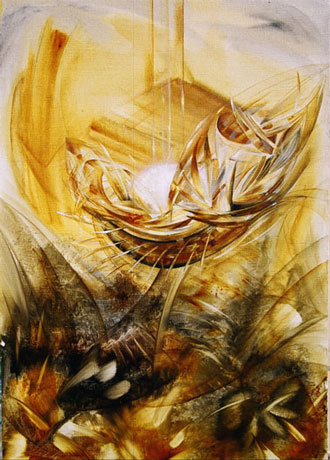
And so we must see that any boat over which such songs were sung became the original boat, sung down from Vainamoinen's mind, strong in magic and the wood and words of the first world.
The Kalevala’s Sampo Songs
Although composed into an artificial elegance by Elias Lonnrot in the 19th century, it is the force of Vainamoinen's clever songs that drive the Kalevala. In the Kalevala, we can learn much about the I adventures of Vainamoinen, the master of songs and most famous Finnish cultural hero. The Kalevala's pages are replete with tellings of creations and destructions, beginnings and endings, giants and riddles, charms and runes, lamentations of loss, the forging of the sun and moon. And Vainamoinen had a hand in much of this. But it is within the Sampo runes or songs of the Kalevala that the full and subtle Finnish expression of the sacred reaches its poetic pinnacle through an artifact of both beauty and obscurity. A mill? An idol? Its true form unknown, the Sampo is the embodiment of creative achievement, beauty, greed, and the anxiety of loss inherent in any ultimately fading human endeavor.
The story of the Sampo begins with longing. Well, things always do, don't they? It is within the heart that passion has its first forge. So even before the fertile Sampo was brought into being by smith Ilmarinen's hands, its potential begins to form in the words of love spoken by Vainamoinen that set the smith's heart turning with desire.
Old Vainamoinen uttered: I have much to tell:
There is a maid in the Northland
A lass in the cold village
Who will not accept bridegroom....
Smith Ilmarinen
You everlasting craftsman
Go and fetch the maid
Look for the braid-head!
If you can forge the Sampo
Brighten the bright-lid
You'll get the maid for your pay
For your work the lovely girl.
(Bosley, 107)
Here, the yet unforged Sampo is suggested as a bride price and may in this way shed some light on its possible metaphorical meanings. Worth the value of a bride, the Sampo comes to symbolize aspects of fertility and abundance, the hopes of a fertile and balanced marriage. Such domestic relationships are themselves symbolic of human hopes for engagements with the lands they live on. The ways we live on the land establish sacred relationships that benefit from our attention and good husbandry. Such attentions in turn foster prosperity of crops and abundant living.
Ilmarinen takes the advice of Vainamoinen and journeys to Northland where Louhi, dark crone of Pohjola, is already expecting him. It seems she does not recognize him at first, but she knows of the Sampo, though it has not yet been forged.
Then the Mistress of Northland
Inquired of the newcomer:
'Have you come to see,
Hear and know about
That Ilmarinen the Smith
The most skillful of craftsmen?
He has long been waited for
And ages longed for, here
In furthest Northland
To make up the new Sampo.
(Bosley, 111)
We learn that she waits for the "new" Sampo, perhaps indicating that this is not the first one, or that the Sampo is part of some larger cycle of events or patterns of exchange between the various worlds of the Kalevala.
Hoping to win Louhi's daughter, Ilmarinen stays in Northland and sets about forging the Sampo which will then become the price of the marriage. Like the hopeful outcome of a marriage, the Sampo is not so much fashioned initially as it is born from the forge. And like a child, it is after its birth that a parent's skill in directing its ultimate character and nature is needed. From under the forge, the Sampo, its "bright-lid growing," begins to crown.
Smith Ilmarinen
At the third day's end
Leaned over to look
At bis forge's underside—
Saw the Sampo being born
A bright-lid growing.
Then the Smith Ilmarinen
The everlasting craftsman
He hammers away
He taps-taps away.
He forged the Sampo with skill;
On one side there's a corn mill
On the second a salt mill
A money mill on the third.
And then the new Sampo ground
- And the bright-lid rocked;
Ground a binful at twilight-One binful to eat
Another it ground to sell
And a third to store at home.
(Bosley, 117)
This is our fullest physical description of the Sampo. It produces wealth of three kinds and rocks like a machine, but its actual form remains obscure. But, as we will see, this obscurity is a vital aspect of the Sampo's power to generate inspiration and desire, as well as prosperity.
The Hag of the North was pleased;
Then she took the great Sampo
Into Northland's rocky hill
Inside the slope of copper
And behind nine locks.
There she rooted roots
To a depth of nine fathoms;
Sank one root in Mother Earth
And one in a riverbank
And a third in the home-hill.
(Bosley, 117)
Hidden away within the living earth of Northland, the Sampo became the abundant churn of Otherworldly wealth. As Ilmarinen points out, with the Sampo under her control, Louhi's land waxes in riches:
... with the Sampo in Northland...
There is plowing, there is sowing,
There are all kinds of growing
There is good luck forever.
(Bosley, 514)
It is perhaps this glowing report (and the fact that Ilmarinen returned home without his promised bride) that leads Vainamoinen and Ilmarinen to mount an expedition by sea back to Northland to retrieve the Sampo. Understandably, Louhi is unwilling to return the new source of Northland's fertility. Upon arriving, Vainamoinen and Ilmarinen are challenged by Northland's Mistress who asks them, "What message do the men have? What news the fellows?" Vainamoinen answers her,
The men's message concerns the Sampo
The fellow's news the bright-lid:
We've come to share the Sampo
To look out for the bright-lid:
She, the Mistress of Northland
Uttered a word and spoke thus:
'No grouse can be shared by two
Nor a squirrel by three men.
Tisgood that the Sampo hums
And the bright-lid turns away
Within Northland's rocky hill
And inside the copper slope;
It is good too that I am
Keeper of the great Sampo.
(Bosley, 547)
We must wonder if it is only her refusal to share abundance that justifies the Sampo's eventual theft by Vainamoinen. Her words imply that the Sampo is too small a thing to kit shared amongst two or three people (or perhaps more than one world or land), but can this really be true of the wondrous "mill" that daily grinds out so much wealth within the hills of Northland? We may also see this as a reasonable assertion of feminine ownership of any object associated with fertility magic. So deciding that its power must be shared, Vainamoinen, makes his intentions regarding the Sampo clear:
Steady old Vainamoinen
Uttered a word and spoke thus:
"Ifyou'll not give a pan, that
Otherhalfofa Sampo
We shall carry off the lot.
We shall take it to our boat.”
(Bosley, 547)
It was said that Louhi, Mistress of Northland, took that very badly. She then convened all the warriors of Northland and set off after Vainamoinen and the Sampo. This kind of myth of theft and pursuit is not uncommon in northern Europe. One of the earliest mentions of King Arthur, in the Welsh mystery-poem, the "Spoils of Annwn," sings of Arthur's harrowing voyage into the Otherworld to seek and steal a cauldron that would, over time, become the archetype for the Grail.
Kept and protected in the Otherworld, such objects function as hallows, but can become personifications of mortal desire as well. We have always sought to control nature. Now modern science follows myth in this regard: we mutate seeds, affect the weather, and bend the cycles of nature to serve human needs. But unlike the myths, science has not yet learned to see the end of the story. In myths, those who seek too much control over nature often lose whatever gains they may have won from the gods. Such mythic losses may also be reflections of larger, seasonal cycles of loss, yearning, quest, and attainment.
In Northland, the Sampo ground out abundance, but when it was stolen back, it was broken and its thieves/rescuers were furiously pursued. Perhaps the great beauty and fertile powers of the Sampo made it inappropriate for the mortal-, or middle-world. Its perfection established it as a holy thing, worthy of memory, and its keeping-place would then need to be (perhaps should have remained) in the Otherworldly Northland where the forces of the ever-fading mortal world could not diminish it. In this way, too, the Sampo shares some similarities with other well-known quest objects—the Grail and Excal-ibur—that are lent to or quested for by mortals. Such artifacts must eventually find their way back to the unfading Otherworld, reinstalled within the realm of memory where they can continue to inspire successive generations of makers and seekers.
At the end of the Sampo songs, after a sea-chase, Louhi (now in the form of an eagle) is struck by Vainamoinen with an oar. Wounded, but with one talon left, she reaches for the Sampo, but then drops it into the sea where it breaks apart. Although clever Vainamoinen might not have foreseen the breaking of the Sampo, even its shattered pieces retained some portions of their original power and so continue to serve a purpose.
So some of those bits, those great
Fragments of the Sampo went
Below the quiet waters
Down into the black mud;
There they were left for the water
Treasures for Ahto-land's folk.
That's why never in this world
Not in a month of Sundays will the water go without
Or its Ahto lack treasures.
(Bosley, 569)
By telling its story, keeping its bright-lid (a threshold to and reminder of whatever mystery once dwelled within it), and knowing that the other parts of it are buried in the sea ("Ahto-land"), people may still partake of the Sampo's song won through Vainamoinen and Ilmarinen's bold quest. The spoils of such tales are too compelling to be kept by a single hand or spoken by a single mouth alone. Their wisdom has become part of the great sea's bounty: plentiful, more than enough to be shared by all.
Shall I start to sing
Shall I begin to recite...
One word from you, one from me
Splendid speech from both ...
(Kuusi: 81)
Even as it appears to us now in a purely literary form, the Sampo remains a gift of mystery, the embodiment of the numinous. It is never described in enough detail to guess its identity. It is a word without a referent. But this mystery is surely part of the Sampo's power if not its purpose, for to inspire questions and quests is a particular definition of the sacred. The Sampo is broken and lost, but we may still tell its story. It continues to sing in Finnish myth and the pages of the Kalevala as an axis of Otherworldly wonder about which human hopes of artistic and spiritual attainment may, at every moment, begin to form.
Карелия
Этнос Карелии
Ментальный капитал Карелии
Культовые места Карелии
Карельская кухня
Волшебники Карелии
Фотографы Карелии
Художники Карелии
Наставление
Как думаешь, так и живёшь.
Думай о хорошем!
Не к миру надо идти в подмастерья, а к Богу, чтобы стать Мастером.
В конечном счете, каждый человек остаётся лучшим учителем для себя — и сам ставит себе итоговые оценки.
Кижи
Астронавигация
Наши контакты


